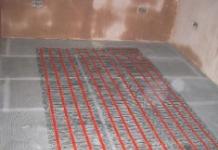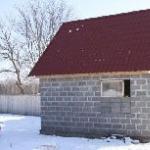The garage, as a rule, is not only the place of residence of your car, but also a cellar, and a repair shop, and a resting place for our men. Everything would be fine, if not to take into account the big frosts. Not only does your car feel uncomfortable in an unheated garage, but so do you. Therefore, in winter, the garage must be heated. A decrease in temperature entails the appearance of moisture, which will gradually destroy the metal. Ideally, each car owner should choose a suitable garage heating for himself and equip such a system. Today we will consider the main types of garage heating with our own hands and the feasibility of each of them.
The need for garage heating
Whatever material you choose for building a garage (brick, cinder block, concrete), in any case, it will not save your “iron horse” during the bitter cold and will not provide an acceptable temperature inside the garage. From April to October in our country it is possible to keep a car in a shelter without creating protective measures. But, starting from the last month of autumn, the microclimate in the garage is changing, and this can seriously harm your four-wheeled friend and the room itself.
The fact is that in the garage with the onset of cold weather, an unpleasant phenomenon appears for metal called condensate, which leads to irreversible corrosion of all metal components of the garage (body, gate) and the car itself. In addition, the car starts much better in well-heated air. The very first thing you can do in this situation is to insulate the garage space.
Insulation for garage walls is often foam concrete blocks or cinder blocks. For reliable insulation of the roof, it is customary to use expanded clay. Make a noticeable layer of laying expanded clay granules - about 15 - 25 centimeters. And on top of it without fail there must be a cement screed. The second most popular thermal insulation material is mineral wool. If iron gates are installed in the garage, then it makes sense to insulate this part as well. And foam sheets will help you, which have a thickness of no more than 5 centimeters. After gluing the sashes with them, the sheets must be sewn up with plywood, clapboard or chipboard.

But in order for your car to be well preserved during the entire winter season, garage insulation alone is not enough! Additional measures should be taken: to equip additional ventilation, which will remove exhaust gases and excess moisture, and to equip the room with the right heating. For a garage, it is enough to keep the air temperature inside above plus 5 degrees Celsius.
Depending on the location of the building, you can choose one of two options for heating the garage in winter:
- Shared heating system with residential building. This method of heating a shelter for a car is very beneficial if the garage is close to the house (up to 20 meters). In this case, your garage will be heated on a par with the house, which ensures very high temperatures in the cold season.
- Autonomous heating system. This technique is used when the car shelter is far from home and the garage cannot be connected to the existing heating system. It is customary to develop an individual heating system, depending on the area of \u200b\u200bthe garage, its design and the number of cars.

Types of garage heating
To make the right decision regarding the choice of heating in the garage, you should analyze your individual situation in detail and think about which system will be most useful to you. When choosing a system and type of heating, you should also pay attention to its efficiency and ease of operation. Calculate your budget in advance so that the arrangement of heating in the garage does not hit your budget hard.
solid fuel
The use of firewood, coal, peat and other solid fuels is the simplest and most economical garage heating. It is advisable to use this technique in case of technical difficulties, for example, in the absence or interruptions in the supply of gas, water and electricity. The main advantage of this device is that it is independent of the power supply. But when choosing this option, you should completely exclude explosives from the garage, and this is quite problematic.
You can use a pyrolysis boiler that will maintain the optimum temperature for 6-12 hours. This boiler is so called because the process of pyrolysis takes place here - the combustion of solid fuel is separated from the substances that are released during the combustion process, as a result of which the set temperature remains unchanged for a long time. For the normal functioning of the pyrolysis boiler, it is necessary to build a forced draft that is capable of supporting combustion. The simplest mechanism that performs this function is a fan. Remember that such a device will have to be cleaned regularly.

A pellet boiler allows you to heat a room with wood pellets, which are pressed from shavings and sawdust. In the commodity market, this type of fuel is called pellets. The process of filling such a boiler with pellets is automated, that is, pellets are fed into the combustion chamber by self-filling through a screw container or bunker. The more raw materials are poured into the boiler, the more heat can be obtained from this design, provided there is excellent ventilation.
The most popular option for heating a garage is to install a Buleryan stove. This unit has a very high heat transfer coefficient and is able to work more than 10 hours on one load of fuel, so its cost is an order of magnitude higher than other heating devices. The garage heating furnace has the simplest design: it is equipped with two combustion chambers and runs on any solid fuel, except for liquid compositions and gaseous mixtures. They absolutely cannot be poured into the oven!
The lower chamber of the furnace is adapted for the gasification of the apparatus, and the upper chamber is for burning solid fuel. For ignition, paper is the best material. If you plan to install just such a stove, then remember that the heating device should be placed at a height of 0.2 meters above the floor, it is better to use insulated sandwich pipes for the chimney, and heat-resistant bricks or concrete for the base of the stove. It is better not to use stainless steel for the chimney, as soot can catch fire or condensation can accumulate.
Gas heating
It is categorically not recommended to equip such heating of the garage on your own, otherwise not only the garage, but also you and the car can fly into the air, because gas is a very dangerous explosive! The installation of gas heating must be carried out exclusively by qualified gas specialists who are able to handle explosive substances. If you really use gas as heating, then only in the form of a gas generator.
The principle of operation of such a unit is as follows: a soldering torch, which is located in the generator, burns gas together with air. The resulting thermal energy enters the heat exchanger and heats the air, which is blown by the fan. Heated air is supplied to the garage, and the products of combustion through the chimney go outside. A new portion of air is delivered to the room through air ducts or grilles specially made in the heat generator itself.

Such a heat source is used as a permanent element for heating the garage when the central gas pipeline runs close. This is an inconvenient moment, however, the use of a gas heat generator has serious advantages over the use of all other methods - the highest heat transfer coefficient. You should also remember that it is more expedient to model such a design in large garages.
Gas as a heat source has a low cost. And if you decide to install such a heating system in the garage, prepare in advance for the fact that the arrangement of the entire system will cost you a round sum, because you will have to spend a lot of money on factory equipment and the work of installers. If you want to save money, it is better to build a garage in places with access to the main gas supply line. Relatively recently, less expensive options began to appear using various models of gas heaters.

Gas heaters running on gas or propane are infrared and catalytic. The principle of operation of a catalytic heater is called ideal in terms of use for a garage, since such a device can generally be used for a living space! The substance burns in the catalyst. Due to this, the device neutralizes 95% of combustion products.
There is also infrared gas heating, the efficiency of such heaters is an order of magnitude higher than that of an electric counterpart. During the combustion of gas, ceramic elements are heated, and heat is supplied to the air along with the products of combustion. You can install such a device if you are ready for constant ventilation of the garage. Also, the disadvantage of infrared devices can be called gradual heating. Therefore, it is more expedient to install catalytic heaters that have a power of up to 6.2 kW.
Water heating
This option is recommended if the car shelter is an integral part of the residential building. But if the garage will stand separately, much more expenses will be spent on heating. You will have to spend a lot of effort and money on creating trenches and pipelines for transporting energy carriers, installing a pump for pumping water. Do not forget to count and purchase insulating materials that protect the pipeline from the cold. In this case, it is also necessary to use antifreeze in the system instead of water to avoid freezing.

Water heating is suitable for garages that are built of concrete, brick or shell rock, and insulated with foam plastic or mineral wool. The water heating system in the garage consists of a boiler, convector or radiator, as well as connecting pipes. The heat generated by the boiler or convector heats the water circulating throughout the system. As a result, radiators are heated, which are made of a metal alloy of high thermal conductivity. Batteries give off heat to the room, and in this way the cycle is repeated.
The garage water heating system is easy to repair and replace heating radiators. It is enough to block and remove the unusable battery, and then put in a new one. It is advisable to arrange water heating of the garage with your own hands, if we are talking about a whole group of garages. Then the cost of work related to the construction of systems will be in an equal share, divided by all participants.

If you are going to independently equip the garage with water heating without the involvement of specialists, then you need to carefully study all the schemes in a wide variety. The main task of such work lies in the correct connection of all the individual elements of the heating system into one. Design is a very important step, because without a preliminary plan you will not be able to accurately determine the number of connecting elements and the length of the pipeline. If you're going to do a freehand drawing, don't forget to take into account all the elements, rotations, battery positions and decoupling.
After that, you can install the heating boiler yourself according to the instructions of the selected manufacturer. As a rule, self-installation of heating batteries is carried out according to one model. First, holders are installed with wall dowels, after which the radiator is hung. Provide in advance that the installation is located at a distance of fifteen centimeters above the floor. After that, metal pipes should be connected into a single system. For this, fittings should be used in places of forks, turns and pipe connections.
Use of electricity
The most common garage heating method is electric heating. Even in Soviet times, car owners thought about how to heat a garage without electricity. But they didn’t come up with anything better, so they used home-made devices called “goats”. They are made simply: a nichrome spiral is wound on an asbestos-cement pipe. Such a heater consumes little power - up to 10 kW! Stationary and mobile electric heaters are also very popular today. Ordinary home heaters may be suitable for this purpose.
When using the electric method, it is recommended to take care of the maximum saving of heat and carry out complex work related to the insulation of the room itself. To achieve a good effect, you can install a fan near the heater, which will increase the circulation of heated air, direct it in a certain direction and reduce the time to heat up the building. The only drawback is the high energy consumption. In addition, appliances dependent on the supply of electrical energy can stop working at any time.
The problem of heating in the garage can be solved with the help of an infrared heater, which is attached to the ceiling and heats the floor. The source of infrared radiation is an electrically heated glass-ceramic or quartz glass element. Unlike a traditional electric heater, an infrared device heats objects like the sun, and they already warm the surrounding air. Thus, the car owner with his working area is located just in a heated area.

This modern type of heating for a person is absolutely harmless, but its action does not affect the paintwork of the car in the best way. That is why it is advisable to install such devices directly above the entrance to the garage, and not above the car. Thus, a thermal curtain is created and your car is protected. However, remember that such electric heating systems cannot be left unattended, as they can heat up to very high temperatures.
Consider another type of garage heating, like an inverter split. Such a system allows you to heat the garage with a voltage of 12 volts, save up to 30% of electricity due to automatic temperature control and work at temperatures that reach minus 20 degrees. Inverter split systems are nothing more than air conditioning systems. Their cost is quite high, not every person can afford to buy a high-quality air conditioner in an apartment, and what can we say about a garage.
air heating
The most ideal way to heat a garage and other technical rooms is air heating. The principle of operation of such a system is to create an intense flow of warm air, which raises the temperature in the room very quickly. This heating is the fastest of all. If you direct a stream of warm air towards your car, then you can achieve the removal of moisture that is present under the car.
The biggest advantage of this garage heating system is the easy installation of equipment without the involvement of specialists. All fasteners you can buy in the store at an attractive price. Another advantage of this type of garage heating is to maintain the required temperature with little heat loss with a short warm-up time. The main device that pumps heat is the fan.

Let's take a closer look at the range of devices for garage air heating. You can install a mains powered oil cooler. This device is very easy to use. The appliance cannot reach too high temperatures and cools down slowly. It is very easy to use, and thanks to the presence of a handle and wheels, it can be moved to any point in the room, as far as the length of the electric wire allows. The main disadvantage of using such an apparatus is the high energy consumption of the device. It takes about 100 kW to heat one square meter.
You can also not bother and purchase a thermal air gun. One is enough. And every time you come to the garage, you can turn on such a gun that warms up the room in a matter of minutes - in 15 minutes. The design of the device is a professional powerful fan in a durable metal case. With the help of a fan, the heat from the heating element is distributed in the room. However, keep in mind that heating the garage for a long time with a heat gun can ruin the paint on the body of your car. And besides, such schemes do not work in a harsh winter, because the garage freezes overnight, and again there are problems with starting the car.
In the garage, you can also install a convector that will work on the principle of natural convection. The heating of the room is carried out due to natural convection, when cold air will fall down, and warm air will rush to the ceiling. Taking into account the principle of operation of the convector, it is recommended to install it on the floor or on the lower part of the wall. The device does not burn oxygen, and is also environmentally friendly and efficient, but this is reflected in its cost. His body is not able to heat up above ninety degrees.
An inexpensive spiral fan heater is also on sale, which has a heating part in the form of a heating element and heats the room well. But the device is a fire hazard, since the spiral located in them is capable of heating up to high temperatures. The combustion of the spiral provokes an intense combustion of oxygen, which makes the air in the garage dry and completely unsuitable for comfortable breathing. In addition, if a variety of third-party particles enter the open coil, an unpleasant odor may appear in the room.
A ceramic fan heater warms up the room well, but is a rather expensive device. The source of heat radiation in such models is ceramic plates, due to which a ceramic fan heater is rightfully called the safest and most environmentally friendly heating device, since the heating temperature of ceramic plates is the lowest compared to a heating element or a spiral, and good thermal efficiency is achievable due to the large heating surface. The cost of purchasing this unit is more than covered by the high quality of the product.
used oil
As an alternative fuel for heating a garage, waste is used - refined engine oil, which is any oil product from synthetic substances or petroleum that has already been used and contaminated during use with physical or chemical impurities. Oil mining is supposed to be disposed of, since it is unsuitable for anything, but craftsmen have found methods for using mining on the farm when heating a garage.
There are special thermal installations for its processing. You can also easily assemble an apparatus for using waste oil with your own hands according to a simple scheme. The exhaust furnace with direct air heating is a device that is intended for heating a garage based on any engine oil that has exhausted its motor resource. The procedure for lighting the oven is also simplified - you need to put some paper inside, pour 1 liter of oil into the oven and set fire to the paper.

Mining will begin to boil in a few minutes, and the process of igniting the oil will begin. It is poured in portions of 5 liters during the combustion process. For use, you can choose any oil-based fuel, but it is strictly forbidden to pour gasoline, kerosene and solvents into the oven. The disadvantages of mining heating are the impossibility of using fuel of a homogeneous composition. In addition, you should be prepared for constant problems that may occur due to different fuel quality.
The stove, which works on mining, is able to function at any temperature, and therefore is invaluable for heating the garage in the winter. This type of heating is considered quite simple and inexpensive, because recycled raw materials can reduce energy consumption by up to 1 liter per hour.

Such an oven is extremely environmentally friendly, as there is no soot and smoke emissions. A serious breakdown of the furnace is almost impossible, because it is assembled using a welding machine and does not have such complex parts as droppers, nozzles and similar devices in its design. The fire safety of the design is another advantage of such a stove. Only mining vapors are burned, and the fire cannot escalate into an open flame. Thus, compared to gas or solid fuel boilers, a treated oil stove is much safer.
However, there are some inconveniences when installing and using a waste oil furnace. The chimney for such a furnace must have a length of at least 4 meters. Horizontal surfaces should not be allowed in the chimney duct, and this is a little difficult to achieve structurally. In addition, you should clean the containers that store oil and the chimney every week. These inconveniences can be partially eliminated by installing a removable chimney and small utensils that are easier to clean.
Garage Heating Safety Rules
When arranging a heating system, no matter what type you choose, you must clearly follow the safety rules, which are as follows:
- You must decide how to heat the garage in winter, even at the stage of building a garage. This is very important, especially if complex and expensive systems are planned.
- If you plan to install heating using a potbelly stove, high-quality supply ventilation must be present in the building.
- If your garage has obvious explosive compounds and various volatile substances, you should not install gas heating. Installation near gas heaters of compounds that provoke metal corrosion is not permissible.
- Never install devices with power that even slightly exceeds the power of your network.
- If you plan to heat the garage with electricity, you should install a fuse so that the devices are immediately de-energized in the event of an overload or short circuit.
- If the outlet is located at a distance from the object, the length of carrying electrical appliances should be no more than 6 meters, and the cross section should be from 2 to 3.5 millimeters square.
- The use of heating devices as drying structures is strictly prohibited.
- It is worth noting that the storage of gas cylinders is only permissible in garages that are above ground level.
- When a gas leaks, it settles at the bottom, and if a small spark occurs, an explosion can occur. Therefore, when entering a room with gas heating, it is recommended to sniff, and then turn on the electricity.
- It is very important to turn off electrical appliances at night or control them, do not let the voltage drop to 180V.
- In order to maintain an optimal microclimate in the garage, thermal insulation and ventilation should be equipped. If you approach the installation of the heating system in the garage in a complex way, you can eliminate the appearance of condensation and corrosion.
- Periodically inspect heating equipment and preventive maintenance.

Thus, we told you the best way to heat the garage. Practice shows us that it is best to equip the garage with air heating, which is the fastest in action, but this option is quite expensive. The most economical way is to install equipment that runs on solid fuel in a shelter for a car. Water heating is advisable to use if the garage acts as an extension to a residential building. The use of gas for space heating is very dangerous and fraught with consequences, so be sure to contact a gas specialist!
Do you want to make the garage comfortable, cozy, really useful for the car? Would you like to avoid the appearance of corrosion on the metal, to prevent the formation of condensate? Do you understand that you will spend enough time in the garage?
You can turn your garage into a truly efficient, comfortable, safe and secure space. It will be possible to store your car, tools, all kinds of things there in excellent conditions, you just need to know how to heat it.
In principle, they even organize a mini-warehouse in the garage, moving there all things from home that are not constantly used. This is a great solution! In addition, you can gather in the garage with a male company, spend a lot of time there fixing the car. We will answer the question of how to heat the garage so that it really becomes comfortable for you.
Today we will look at the main garage heating methods, the most effective, economical and simple. We will also pay attention to the nuances of choosing a heating method, some safety rules.
In our country, the temperature regime is regularly extreme. Even careful insulation, high-quality materials for construction and structural integrity, tightness of the seams still do not guarantee warmth in the winter cold. It is especially bad in the garage in bitter frosts, which are familiar to our climatic conditions.
The problem here is not only to create comfortable conditions, but also to ensure safe reliable storage of the car. If you do not heat the garage in winter, condensation will form in the car, on the parts of the car, including the inside. Ultimately, this leads to corrosion of the metal. And the car will last less, it may start to break down, there will be failures in different systems. What then is the point of storing the car in the garage? It is important to know how to properly heat your garage in order to really use it effectively!
Note! Even a very high-quality modern insulation, perfectly fixed, will not save your car from the harmful effects of cold, temperature changes and condensation.
Of course, the room also needs to be insulated. To do this, use mineral wool, foam concrete blocks, as well as cinder blocks, which have not lost their popularity for many years. The roof is usually additionally insulated with expanded clay granules. It is also desirable to insulate iron gates additionally, using foam plates for this. But the most important missing link, given the severe frosts in our lane, is still heating the garage.
Appropriate temperature must be maintained inside the room. It is not at all necessary to create conditions there, as for living. It is enough to maintain the level of air heating up to 5 degrees.
Heating the garage in winter
Let's find out how best to heat the garage in winter so that the car is in the best conditions, while the entire heating process is quite economical, efficient, and requires minimal investment. There are two ways to heat in winter.
- Heating system. This technique is usually used if the garage is located far from the living quarters. Then the connection of his heating system to the communications of the house will not be economically justified. When the heating system is individual, it is carefully designed, taking into account the number of cars in the garage, design features and total area.
- General communication system. This means that the heating system will be connected to the general communication network of the residential building. This method is relevant and justified if the garage is located near the house, at a distance of about 20 meters, no more. With this heating in the garage will always be warm, almost like in the house.
Your choice is which system to define for the garage. It is advisable to focus here primarily on economic efficiency.
Types of heating
Consider the main types of garage heating. To choose the best option, you need to carefully analyze all the features of your garage space. Try to choose the best option that combines efficiency and economy.
Gas heating
Be sure to remember! It is strictly forbidden to install this method of heating the garage with your own hands! This can lead to serious consequences, since working with gas is associated with an increased risk. It is necessary to have special equipment, possess all relevant skills, thoroughly know safety precautions and have a special permit for such work.
However, you can easily carry out gas heating in the garage using the services of craftsmen.
You can install a gas generator. It works on a simple principle. The design has a soldering torch. It burns gas, and as a result, thermal energy is generated. It enters the heat exchange element, and then warms up the room. The air is heated by the fan. At the same time, all harmful combustion products go outside, but the heated air masses remain inside the garage. The next portions of air will be delivered using special air ducts.
Unfortunately, the generator can be effectively used only if there is a central gas pipeline nearby. At the same time, everyone recognizes that this method of heating the garage is still economical, since a very high heat transfer coefficient is created. The best option is to use a generator in a large garage.
By itself, gas is quite expensive. This must be taken into account when choosing this heating method. You will need to invest serious money in installing a heating system. In the future, you will need to constantly pay for the consumed fuel.
There are catalytic and infrared type heaters. With infrared gas heating, the efficiency of the device will be quite high, surpassing the performance of electrical analogues. During operation, ceramic elements are heated, after which the heat is already sent into the air. But it will go along with the products of combustion. Ready to ventilate regularly, make an excellent ventilation system? Then this method is for you.
With catalytic heating, the ecological purity of the air is observed. The option is very interesting, because all substances are burned directly in the catalyst, after which 95 percent of the combustion products are neutralized.
solid fuel
Many choose it to heat the room, since this method is the most affordable, simple, and does not require serious investments. In principle, there are no tricks here. Even if there are problems with the supply of water, gas, fuel heating will always save in any situation. Heating devices are independent, autonomous.
A very important point! If you decide to use solid fuel, you will have to remove all explosive substances from the garage. And in the garage, such security, unfortunately, is quite problematic to provide.
There are several options for heating a garage space with solid fuel.
- Pellet boiler. It is heated with compressed sawdust, shavings, wood pellets. The boiler is filled with fuel automatically. With more raw materials, the boiler will give off more heat. A prerequisite for using such a boiler is an excellent ventilation system.
- Pyrolysis boiler. This heater is able to maintain the required level of temperature in the room for 12 hours. It is advisable to set the draft to maintain normal combustion. The most elementary option is to install a fan. It will need to be cleaned frequently.
- Buleryan oven. The most popular modern method of garage heating. The device has a high heat transfer coefficient. Works more than 10 hours after a single loading of raw materials. Remember! Such a furnace works exclusively on solid fuel. It is strictly forbidden to pour liquid into it.
Choose what suits you best.
Electric heating
Electric garage heating is the most widely used. Motorists prefer mobile, stationary electric heaters because they are quite easy to use and relatively economical. Even a simple home electric heater can be installed in a garage to maintain the optimum temperature there.
During the operation of an electric heater, experts recommend ensuring maximum savings in thermal energy. For example, a fan is installed near the heater. As a result, air circulation is enhanced, while directing the air flow in a specific direction. The period of warming up the room is also reduced.
True, there is a significant drawback here: a lot of electrical energy is consumed. And there is a dependence on the supply of electricity. You can no longer call such a heating device autonomous.
An interesting option is infrared heating. The heater is attached to the ceiling surface and then provides floor heating. In this case, the source of infrared radiation is a special element made of quartz glass, ceramics. It is heated by electricity and provides infrared radiation. There is a difference from the usual electric heater: objects are heated, and they are already warming up the air. You can easily define a specific area for optimal heating and direct infrared healing directly to it.
There is one nuance. Note! This method of garage heating attracts with environmental cleanliness, safety for human health. However, such radiation can damage the car paintwork.
There is an exit. You can just take care of maintaining the distance between the machine and the heater. Warm up the working area, the area near the gate. So you will provide a good thermal curtain, a barrier between the room and the external environment.
It is strictly forbidden to leave such systems unattended for a long time, as they can heat up to extreme temperatures.
A good option is to install an inverter split. This modern system already enjoys well-deserved trust and popularity. A minimum voltage of only 12 volts is enough to provide heating for a garage space. At the same time, the saving of electrical energy will be 30%. You can work effectively even in frosts of -20 degrees. We can say that the inverter is an air conditioning system.
Unfortunately, there is a significant downside. Safe, reliable, environmentally friendly and efficient inverter heating systems are quite expensive. Therefore, not everyone decides to purchase such a device. However, this investment justifies itself, pays off quickly enough, in addition, it allows you to significantly save electricity.
air heating
It is this type of garage heating that many recognize as the most efficient and economical. A stream of warm air masses is created, which ensures a rapid increase in temperature in the room. Heating is the fastest.
An essential advantage of air heating systems is simple installation in a short time. You do not even need to call the masters. The necessary fasteners are always available in stores, they are inexpensive.
The key element that blows warm air is the fan. The room temperature will be constantly maintained at the same level. Heating is fast, the climate is stable, and heat loss is minimal.
Consider the main devices that provide air heating to the room.
- With pleasure, many owners purchase air heat guns. It is quite economical, simple and effective. You can take only one gun per garage. Warming up the room with such a gun is provided in just 15-20 minutes. Such a gun is a powerful fan, which is located in a durable metal case. There are also disadvantages. In winter, heating the garage with a cannon is not very effective, because the room freezes through the night anyway, it will be difficult to start the car. In addition, frequent heating with heat guns can adversely affect the paintwork of the car.
- The oil cooler operates by receiving power from the mains. It just cools down and doesn't get too hot. The operation is simple, the device is mobile, moves on wheels, as long as the wire allows. However, it will consume a lot of energy.
- The convector ensures the separation of air masses into warm and cold streams. Heat rushes up, and cold - to the floor. Given this factor, it should be installed on the bottom of the wall, on the floor. The device is efficient and environmentally friendly. But the price is quite high.
- A ceramic thermal fan allows you to maintain a comfortable temperature in the room, but its cost is high. The heating source is special ceramic elements. The heating surface is large, resulting in high thermal efficiency. The device is environmentally friendly and safe. The unit is expensive, but it pays off very quickly, justifying all investments. Therefore, it is worth thinking about purchasing it.
- The spiral heat fan is cheap. It warms up the garage well, pretty quickly. But be sure to pay attention to the features of the operation of such a device! It is recognized as a fire hazard, since the coil sometimes heats up to the limiting temperature. When the spiral burns, oxygen begins to be burned very intensively, which significantly reduces air quality. It can become dry, unsuitable for good breathing. Quite often, an unpleasant foreign smell appears when foreign particles or dust appear on the spiral.
Garage Heating Safety
In the process of designing and arranging a garage space heating system, it is extremely important to think about safety and follow all the rules. Let's highlight the key points.
- If you plan to store explosive mixtures in the garage, gas equipment cannot be installed.
- It is advisable to think over the technology for heating the garage in the winter even at the stage of building a garage room.
- When heating a garage using electricity, it is imperative to install fuses. If there is a network congestion, the devices will not stop working.
- Be sure to comply with the network power requirements. It is forbidden to install devices that are more powerful than the network.
- There may be a gas leak if you are using this type of fuel. It is advisable to sniff the air before turning on the light in the garage. In this way, a gas explosion can be avoided.
- Never use heating devices as dryers!
- It is important to ensure a good level of ventilation of the room, to make decent thermal insulation. Then the heating will be more efficient.
- Electrical appliances should be turned off at night.
- Make sure that the voltage does not fall below 180 V.
- It is necessary to regularly carry out preventive work, inspect heating appliances.
The choice, of course, is yours. However, experts recommend not to save on heating appliances. First of all, it is necessary to take care of safety, efficiency, environmental friendliness.
To date, many types of heating systems have been developed and implemented in practice, which can be successfully used to heat a garage. Before giving preference to any particular option, familiarize yourself with the key features of each of them and, based on the information received, make a choice.
The principle of operation of the system is based on the circulation of heated water in a closed circuit from the boiler, pipes and heating batteries. The boiler generates heat, heats water, which, usually with the help of a pump, is sent through pipes to the batteries, and they heat the room.

Among the indisputable advantages of water heating, it should be noted:
- long service life. Under the condition of high-quality installation and careful operation, the system will regularly serve for decades;
- reliability. In the event of a failure of pipes or batteries, they are replaced without any problems with their own hands;
- environmental friendliness and high safety performance.
Despite its many strengths, water heating is rarely used in garages. The equipment of such a system requires serious financial costs. Most often, such heating is used in cases where the garage is located next to the house or in garage cooperatives, provided that several garages are connected to the boiler and other related units.

Water heating is best used in solid garages made of solid concrete blocks and bricks. It is recommended to refrain from arranging such a system in buildings made of metal profiles and other light materials.
Gas is one of the cheapest fuel options suitable for arranging a heating system. Along with this, it must be remembered that the installation of a gas heating system requires quite significant financial investments.

The main item of expenditure is the purchase of equipment and payment for the services of specialists from the relevant services. It is prohibited to install a gas boiler on your own and take it into operation without inspections and obtaining appropriate permits. Gas is an explosive substance, so it is clearly not worth playing with it.
The key advantages of this system are:
- high efficiency, therefore, and efficiency of work;
- available fuel cost.
The main disadvantages are as follows:
- potential fuel hazard. Gas, as already noted, belongs to the category of explosive substances;
- high costs for the arrangement of the system.
In addition, full-fledged gas heating can be equipped only if it is possible to connect to the central gas pipeline. It is hardly possible to talk about great convenience if you have to regularly think about the need to refuel empty cylinders with gas and transport them.

Recently, more and more often garage owners decide to organize the heating of their property with the help of modern electrical appliances. The choice is very large: from small fan heaters to full-fledged convectors and even infrared heaters.
Before organizing such heating, it is important to correctly calculate the power so that as a result you do not freeze or overpay for the wasteful consumption of electricity, which is quite expensive.
The undeniable advantages of electric heating include the following factors:
- a large selection of efficient devices. You can easily choose a heater for your garage;
- ease of installation and connection;
- ease of use.
Main disadvantage- high consumption of electrical energy and, in fact, dependence on electricity. In many regions, the stability of the power supply remains more of a myth than a reality, so you should think several times before arranging electric heating.
Otherwise, such systems are the most convenient and versatile.

Air heating of the garage is based on the use of special heat guns, heat fans and curtains. All work according to a simple principle: the device is connected to the network - the built-in fan pumps air - it passes through the built-in heating device - the room is heated.
Such devices allow you to warm up the premises of a wide variety of areas in the shortest possible time. There are both electric models that operate from an ordinary household network, and fan heaters that use a variety of fuels for their work.
Main advantages:
- rapid heating of the premises;
- maintaining the temperature at the desired level;
- ease of connection and use.
The disadvantages include except perhaps the relatively high cost of maintaining the system in the case of using electrical appliances. Also, under the influence of air flow in the room, dust will rise and settle on various objects. Therefore, the garage will have to be cleaned regularly.

A relatively rare, but no less effective option for heating a garage is the use of special stoves that run on waste oil.
If desired, such a stove is easily assembled with your own hands. The design of the unit is extremely simple, so there will be no problems with the arrangement of heating.
The big advantage of such furnaces is the possibility of using waste material for their operation, which saves on heating. However, their big drawback also emerges from here - the need to equip a place for storing fuel and, in fact, the time and effort spent on searching for this very mining.

Although it is usually possible to agree on the purchase of mining with employees of the nearest service station. Therefore, this option also deserves the right to life.

Solid fuel heating. Furnace Potbelly stove
With the advent of special long-burning boilers, solid fuel heating has reached a new level. Modern heating units are characterized by maximum economy and efficiency, and you can make an ordinary potbelly stove or the same buleryan with your own hands. Significant costs for the assembly of such units are not required.
The advantages of solid fuel heating include:
- independence of most models of boilers and stoves from the supply of communications;
- the possibility of assembling heating units with your own hands.
The main disadvantage solid fuel heating systems is their potential fire hazard. In accordance with safety requirements, if the garage is equipped with solid fuel heating, no explosive substances can be stored in the room.
A solid fuel stove must be constantly monitored. In addition, such equipment requires the arrangement of a high-quality garage ventilation system and regular cleaning.
Buleryan oven: assembly guide

A Buleryan type stove is perfect for heating a garage. It is a little more difficult to assemble it than the same potbelly stove, but the unit in question has a much more impressive efficiency and, in general, has improved performance properties.

The design is assembled from bent tubes and a firebox. The unit is equipped with a door for loading solid fuel and a power control device that allows you to set the desired intensity of combustion. A compartment for secondary combustion of fuel is built into the furnace compartment.

A smoke exhaust structure must be connected to the buleryan through a pre-built pipe. It is strongly recommended to make high-quality chimney insulation, for example, with mineral wool. Insulation will further increase the efficiency of the stove.

Of course, the buleryan is equipped with a blower, through which air will be supplied to the furnace compartment of the stove. Without it, the fuel simply cannot burn.

For greater convenience, a small chamber for collecting ash is arranged. In order to further increase the efficiency of the equipment, the rear wall of the unit must be made double. Some models even suggest the arrangement of a two-layer case.

The work on assembling the furnace will consist of two main stages: preparation of structural elements and their connection into a single product.
First step. Prepare your source materials. The main ones are sheet metal with a thickness of 6 mm or more and steel pipes with a diameter of about 5.5-6 cm. Of the main working tools, a pipe bender and a welding unit should be distinguished.
Second step. Cut the pipe into equal parts in the amount of eight pieces. Each piece should have a length of about 120 cm. Bend each pipe with a tool known as a pipe bender under 225 mm and arrange the products on top of each other in a checkerboard pattern.

Third step. Make a T-shaped chimney. Install a faucet at the bottom of the chimney to remove excess condensation moisture.
Fourth step. Make a damper to control the level of thrust. Also prepare a blank damper for the blower. Gate valves are fixed using springs.

Fifth step. Make the front door of the stove. This is one of the most important design elements. The front door should close almost hermetically. The tighter the door will fit to the body, the more efficient the operation of the heating unit will be.


Sixth step. Cut 2 rings from a pipe with a diameter of 35 cm. The size of the rings should be such that one of them almost fits snugly into the second. To do this, cut two parts 4 cm long each from the pipe of the mentioned diameter. Cut and unfold one such segment, and then make the front part of the buleryan out of a smaller ring.
You will need the second ring when installing the door. It will need to be attached to a metal circle by welding.
Also, an additional ring will be fixed on the door by welding. The diameter of this element should be slightly smaller than the diameter of the ring installed on the front of the buleryan. You will fill the gap between the welded rings of the door with an asbestos sealing cord and only after that install the damper.
After preparing all the main structural elements, you can proceed directly to the assembly of the stove.
First step. Make holes in the first two bent pipes and weld special injection pipes into them. The latter should be about 15 cm long and about 1.5 cm in diameter. Thanks to the injection tubes, the proper connection of the convection parts and the combustion chamber will be ensured.
Second step. Weld the tubes into the buleryan frame. The design of the furnace provides for the presence of a partition. It is made of sheet steel with a thickness of 6 mm.

Third step. Close all gaps between the welded bent pipes with metal strips, and then weld the back wall of the furnace. This will form the body of the unit.

The back, metal strips and the partition mentioned earlier will be more convenient to cut according to pre-prepared patterns.


Fourth step. Make a lock on the door. This is an eccentric for securely fixing the metal loop on the wall of the furnace unit housing. The rotation of such an eccentric will ensure the most tight contact of the door with the stove. Making an eccentric requires skills in milling and turning. In their absence, order the manufacture of the lock to a specialist.
Fifth step. Fasten the hinges and hang the door.
Sixth step. Weld the bent support legs to the body.

Seventh step. Attach the chimney to the body of the furnace using a pipe specially designed for this.
On this buleryan is ready. You can start heating your garage.


Successful work!
Video - Do-it-yourself garage heating
To heat the garage, you can easily make a wood-burning stove with your own hands. It will not take much time and will be quite inexpensive, since the use of improvised materials is allowed.
Why is it necessary to heat non-residential premises?
State standards establish that the air temperature in the garage should not fall below + 5 ° C. If these standards are not adhered to, the engine will not start, especially after a long period of inactivity of the vehicle.
In severe frost, even antifreeze can freeze. Significantly increases the number of car breakdowns due to the negative impact of hardened water. Also, you must agree, it is much more comfortable to carry out vehicle repairs in the heat.
Advantages and disadvantages of wood heating
By choosing solid fuel as an energy source for heating a garage, you can get the following advantages:
- low cost of firewood;
- no need to buy expensive installations and additionally spend money on electricity;
- small dimensions of the stove with high productivity;
- the heater can be additionally used for cooking and heating food;
- ease of manufacture and installation of wood-fired units. No need to additionally equip a massive foundation.
The disadvantages include that such heaters quickly heat up, but at the same time they also quickly give off heat to the environment. To maintain the optimum temperature, you need to constantly throw fresh firewood. Fuel consumption increases significantly.
Varieties of heating devices
To heat the garage, you can do the following types of stoves with your own hands:
- potbelly stove with a metal case;
- brick oven;
- long-burning heater.
To independently install a potbelly stove, you need to have the skills to work with a grinder and a welding machine. Brickwork in this case is much easier to produce.
Potbelly stove - manufacturing features and structural elements
Potbelly stove scheme
This is a fairly simple design, which consists of the following elements:
- loading chamber or firebox;
- grate;
- blew;
- ash pan;
- metal door;
- chimney.
For the manufacture of the installation, use thick metal with a thickness of 4 mm. When attaching the chimney to the upper wall of the combustion chamber, it must be strengthened. This place is considered the weakest, the metal most often burns out here.
Use a strong metal mesh as a grate. You can take ready-made or do it yourself from a corner or wire. Make many small holes in the grate to remove ash.
Step-by-step instructions for making a potbelly stove from a steel pipe
- Use a steel pipe with a diameter of 0.4-0.5 m and a length of 1 m to which the legs need to be welded.
- From the steel sheet, cut out two circles of the same diameter as the pipe.
- In one circle, make a door for the firebox and a hole for the blower.
- The length of the grate is equal to the length of the potbelly stove, and the maximum width is equal to the diameter. It is best to use a metal mesh with a width that is slightly smaller than the diameter of the case. Insert it into the pipe and weld it to the walls.
- Weld metal circles to the pipe. Watch the quality of the seam to achieve tightness of the stove.
- Attach the hinges near the hole in the circle, on which you will put the doors.
- On the housing cover closer to the rear wall, make a hole with a diameter of 100 mm for the chimney pipe.
The following diagram of a wood-burning stove for a garage is suitable if you do not have a metal pipe. It is very easy to make it with your own hands, using metal scraps.
Manufacturing technology:

Potbelly stove made of bricks
To install a brick oven for a garage with your own hands, you will need to additionally fill a small slab foundation with a depth of 200 mm. Lay out the combustion chamber completely with refractory bricks.
On the front wall of the structure, leave a window for the door and blower. From parts of the brick, make small protrusions on the bottom of the heater for installing the grate.
To mount the cover, lay reinforcement on the walls. From above, lay 1-2 rows of bricks.
Also, for the arrangement of the upper wall, you can use a metal sheet. Lay it on a potbelly stove, after which cover the cracks with fireclay clay. At the top of the device, provide a hole for the chimney.
The design of long-burning furnaces
Due to the presence of a special damper, home-made stoves of this type are very effective, since the firewood does not burn, but smolders for a long time. With the help of blowers, you can control the intensity of the flame and the power of the heater.
Schematic representation of a long burning furnace
To make a garage heating installation with your own hands, you need to use a metal tank with a volume of 200 liters. In its upper part, make a hole for a chimney with a diameter of 150 mm. Also provide a hole for the pipeline through which fresh air will enter the barrel.
For the weight, cut out a circle of metal that matches the diameter of the barrel. Weld channels to it. Also make a hole with a diameter of 100 mm, where to insert a small piece of pipe. Place such a load in a barrel under the lid. In the body of the heater, make two holes for fuel supply and ash removal. Each of them is additionally equipped with doors.
Making a heater with your own hands is quite simple, using simple materials - a metal sheet or a barrel, corners, pipes, bricks.
Video: Super potbelly stove for the garage
Motorists often form a special relationship with the garage. They perceive it as a cozy place where they can do what they love - taking care of the car, spend their free time there, and try to create the most comfortable conditions. Therefore, the arrangement of the heating system is necessary not only to ensure acceptable storage conditions for the machine, but also for the convenience of its owner. Garage heating should be inexpensive, efficient and safe. What system to mount? Each motorist makes his own choice. Consider which options are most common, find out the reasons for their popularity, analyze the advantages and disadvantages. The goal is to find the most economical heating, which will give the best result with the minimum burden on the budget.
Comparison of heating sources among themselves
If the building is located at a distance of no more than 20 m from the house, the problem is solved automatically - they equip a common system with the house. For garages located farther away, autonomous systems are needed, and gas, electricity, solid fuels and used engine oil can be used as heat sources.
In large garages, installing heaters will not solve the heating problem, it makes sense to install a boiler and equip a water heating system
Gas - cheap and efficient
The most economical garage heating is, of course, with the help of gas, but it requires connection to the central highway, paperwork, permission from the competent authorities. Despite the numerous tips for self-installation of gas systems available on the network, we will not recommend the installation of gas systems with our own hands. Gas systems should only be handled by specialists. In addition, equipment can be installed only if the room meets all sanitary standards: there are ventilation ducts, the ceiling height is not lower than 2 m.
A more affordable and simple way of heating is the use of liquefied gas. Convectors, ceramic stoves, gas panels, heat guns, infrared heaters are installed as heating devices.
The main advantages of gas heating:
- profitability;
- high efficiency;
- high degree of system automation;
- uninterrupted heating throughout the day.
Flaws:
- any, even the most reliable, gas equipment is potentially explosive, therefore, violation of safety regulations during design, installation and operation can lead to serious damage;
- supplying main gas is not always possible, it is associated with troubles and costs.
Do not ignore the danger and do not violate the rules and regulations governing the installation and connection of gas equipment!

If it is possible to connect to a gas main, the cheapest heating option would be to install water heating connected to a gas boiler
Electric heating
The option of installing an electric heating boiler for the majority disappears immediately, because more expensive heating cannot be invented. But a portable electric heater for the garage is the choice of many motorists. It perfectly solves the problem of maintaining the desired temperature, you can always choose the model of the desired power, but there are also unpleasant nuances. It is difficult to call electrical equipment reliable. In addition, it is impossible to guarantee an uninterrupted supply of electricity, and access to it is not always there. As heating devices use,.
Please note that if you plan to install electrical heating equipment, you need to take care that there are no combustibles, lubricants, paints and flammable materials in the room.

If installing a heating system with an electric boiler is impractical due to high costs, then a portable heater may well be a worthy alternative. Electricity costs are high anyway, but a mobile heater is cheaper and doesn't require installation.
Heating with solid fuel
Solid fuel allows you to create a completely autonomous heating system that does not depend on either the presence of an electrical network or a gas main. You can put a stove in the garage or equip heating with a solid fuel boiler. Wood, coal, sawdust are used as a heat source. It is economical, provides thermal comfort, if desired and with the necessary skills, the stove can be made by hand. Disadvantage: it is undesirable to store combustible and flammable materials indoors. The operation of the heater must be constantly monitored. The furnace or boiler must be cleaned periodically.

If there are materials, time and desire, the owner of the garage can make a homemade potbelly stove and save on heating arrangements
Mining - alternative fuel
For an economical owner, just a gift of fate, because the use of recycled materials allows you to reduce heating costs to a minimum. Approximate fuel consumption - 1 liter per hour. Oil before use must be cleaned in special heating plants. Such an installation can be assembled independently. The only serious drawback of the mining stove is that it can fail, since the fuel is of poor quality, it is impossible to achieve uniformity in its composition.

The device of the furnace, working on recyclable materials, is simple. If desired, both the oven and the oil purification system can be made by hand
The best heating boilers
When the issue with the choice of energy carrier is resolved, it is necessary to determine the type of heating boiler. It should be economical, easy to use, and have a high efficiency. Depending on the heat source, you can choose:
- Gas. The ideal option is a condensing boiler equipped with control automation. In addition to the cost of fuel itself, you can also save money due to the ability of the boiler to operate at low pressure. In the heat exchanger of the unit, water changes from a vapor to a liquid state, which leads to the release of heat. Thanks to this principle of operation, the boiler is 15% more economical than gas models of other types. You can also install a wall-mounted gas boiler, which provides power modulation.
- Solid fuel. Best to buy. The principle of operation of the unit is based on the effect of high temperatures on wood, as a result of which it decomposes into pyrolysis gas and dry residue. The gas is burned. For the operation of the boiler, a buffer tank is needed, it accumulates heat. Of all the solid fuel models, pyrolysis models are the most economical, but there is a caveat: in the absence of wood, coal cannot be used for heating.
- Electrical. If you need to effectively heat the room and prevent overloads in the electrical network, it is better to choose a boiler with six heaters and thyristor control. Thanks to the features of the device, you can limit the power and save, an additional plus is silent operation. There is only one minus, but a significant one: heating with electricity is always expensive, because. electricity is the most expensive source of heat.

The cheapest heating for a garage is a gas condensing boiler, other types of units can be more affordable, convenient, but they are all more expensive to operate
What is better for a capital garage?
An insulated garage made of brick, concrete or shell rock is usually well insulated, so you can save money by equipping the right heating. Most often design water systems; air ones are used less frequently, but are also popular. If we compare these systems in terms of capital costs, then at first glance, air seems cheaper, but operating costs are of fundamental importance, and from this point of view, water is better. Properly designed and well-installed water heating lasts much longer and is cheaper.
Arrangement of water heating
The initial stage is design. It is necessary to draw up a drawing on which all elements, the location of radiators, and turns will be marked. When installing the boiler, you must follow all the recommendations of the manufacturer, noted in the instructions. For batteries, holders are attached with wall dowels, after which radiators are hung at a height of 15 cm from the floor. Pipes are connected with fittings.
There are no particular difficulties in the installation of water heating, it is quite possible to do it yourself. If you do not have the necessary skills, then it is better to entrust this work to specialists. If planned, be sure to invite the gasman, do not take risks by installing and connecting the equipment yourself.
Air heating systems
The principle of operation of air heating is based on the creation of warm air currents that quickly warm up the room. If the system is installed in such a way that the air flows in the direction of the place where the machine is standing, effective moisture removal and corrosion prevention can be achieved. Installing air heating equipment is less labor intensive than installing a water system. The main thing is to choose the right model of a thermal device of the required power. Most often, motorists choose fan heaters and thermal curtains for garages.
Infrared Electric Heaters
These devices are popular due to the ability to create local zones of thermal comfort, ease of installation, economical power consumption, no need to install smoke exhaust systems, etc. The devices do not dry out the air, operate silently, warm objects and people, so that heat is not dissipated in vain. The air in a room heated by an infrared heater is heated indirectly - from heated objects. When installing such a device, it should be remembered that prolonged direct exposure to radiation on paintwork is undesirable. The main disadvantage is the same - the high cost of electricity.
Summary
Not only the temperature regime in the room depends on the choice of the heating system for the garage, but also the durability of the car, the feeling of comfort for the owner. Cold and dampness in the garage are unacceptable, as they stimulate corrosion processes and adversely affect the condition of any equipment. Decide on the most affordable source of heat, consider which system will be convenient - and get down to arranging a comfortable garage. Good luck!


















